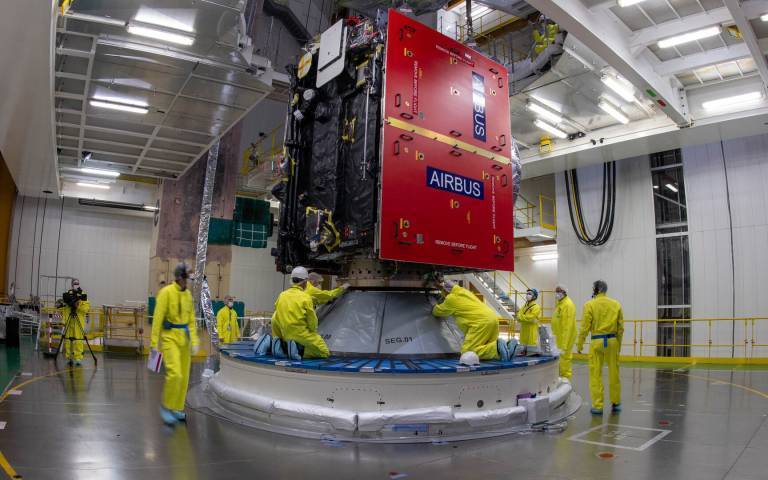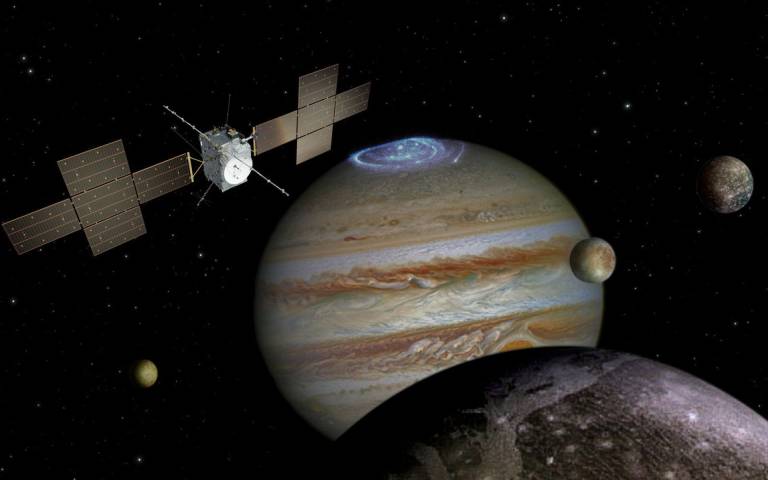Jupiter icy moon explorer prepares to discover new worlds
12 April 2023
A Jupiter-exploring mission, which includes hardware provided by UCL scientists, is due to take off tomorrow (Thursday 13 April) and will investigate whether some of the planet’s icy moons are home to conditions that could support life.

The European Space Agency’s Jupiter Icy Moons Explorer (JUICE) will spend eight years travelling to the Jupiter system. On the way, it will perform fly-bys of Earth and Venus, using the gravitationalm fields of the planets to generate enough speed to reach Jupiter. One of these will be the first ever lunar-Earth gravity assist manoeuvre.
UCL researchers, funded by the UK Space Agency, provided particle detectors for the spacecraft’s Particle Environment Package (PEP), which will sample the particles whizzing around Jupiter, including, potentially, from plumes of water spraying up from the moon Europa. UCL is also involved in the science teams for two other instruments: the J-MAG magnetometer instrument and JANUS optical camera system.
Professor Geraint Jones (Mullard Space Science Laboratory at UCL and The Centre for Planetary Sciences at UCL/Birkbeck), a co-investigator on the PEP instrument and a member of the JANUS instrument team, who is coordinating plans for JANUS to study Jupiter’s aurorae, said: “It’s fantastic to see JUICE, carrying the PEP instrument that we contributed to, nearing its launch. We look forward to seeing data from our sensors on the ‘soup’ of ions, electrons and atoms surrounding Jupiter and its moons. This data will help us, for instance, to understand how particles around Jupiter reach such high energies – energies that could be fatal for an astronaut.”
On arrival in 2031, JUICE will circle Jupiter and fly past moons Ganymede, Europa and Callisto, making observations and taking measurements, studying the Jovian system as an archetype for gas giants elsewhere in the universe.
Finally in December 2034, JUICE will transfer into orbit around Ganymede, becoming the first spacecraft ever to orbit a moon other than Earth’s. While up close and personal with Ganymede, the mission will investigate the giant ocean that scientists believe hides under its icy crust, seeking evidence of habitability.
Professor Andrew Coates (Mullard Space Science Laboratory at UCL and The Centre for Planetary Sciences at UCL/Birkbeck), a co-investigator on the PEP and JANUS instrument teams who in 2012 helped get the mission selected as a member of the ESA Science Definition Team, said: “I’m particularly looking forward to the PEP and JANUS data from [Jupiter’s moons] Europa and Ganymede’s weak watery atmospheres. We anticipate flying through potential plumes from Europa’s subsurface ocean, and with PEP we hope to measure the particles at work in these interactions.
“If we find negative chlorine ions at any of the moons, as we have simulated, this would be direct evidence for subsurface salty oceans.
“Ganymede’s ‘magnetosphere within a magnetosphere’ is also especially exciting and leads to interesting and unique effects like magnetic reconnection – the breaking and reconnecting of magnetic field lines – and the extremely powerful aurora we see at Jupiter’s poles.
“Ganymede’s unique magnetic field means that it has its own weak aurora too, as found by the Galileo mission. We look forward to flying through and exploring this more, amongst the many exciting science goals, like determining Ganymede’s interior structure as JUICE orbits this intriguing moon from late 2034.”
Our very own, Astrophysicist, Professor Nick Achilleos (UCL Physics & Astronomy and The Centre for Planetary Sciences at UCL/Birkbeck), a member of the science team for the J-MAG instrument, said: “One of the prime science goals for the J-MAG is to isolate, from the complex magnetic environment of Ganymede, the small magnetic signal corresponding to induced currents flowing in the subsurface ocean which is likely to be present. The variability and strength of this induced field signal will hold important clues as to the salinity, depth and thickness of Ganymede's ocean."

The UK Space Agency invested £9 million into the JUICE science payload, by supporting three critical instruments on board: J-MAG, JANUS and PEP.
JUICE is a collaboration between ESA, NASA and the space agencies of Japan and Israel and will consider two key themes from ESA’s Cosmic Vision 2015 – 2025: What are the conditions for planet formation and the emergence of life? And how does the Solar System work?
JUICE will spend its eight-year voyage productively; it will pass by Venus to test and calibrate its instruments, gather data and take advantage of the gravity assist to save on fuel. Meanwhile, scientists on the ground will work on finalising software and data modelling in time for arrival at Jupiter.
The particle detectors for the JENI and JoEE sensors on the PEP instrument were built by West Sussex-based company Micron Semiconductor Ltd. Professor Coates and Jones helped to design them, and tested and characterised them, investigating how they responded to different doses of radiation.
Update on 17th April 2023: The date of the launch had to be delayed by about 24 hours due to the weather. In the end, the launch went ahead successfully, commencing Friday 14th April at 14:14:36 CEST. The launch was perfect, with the current spacecraft trajectory being fully nominal. In orbit commissioning will now start, with JMAG boom deployment towards the end of this coming week and JMAG commissioning about 10 days later.
Images:
Top - JUICE meets Ariane: ESA’s Jupiter Icy Moons Explorer (JUICE) on top of the Ariane 5 rocket that will carry it into space. Technicians are working atop the rocket, bolting down Juice’s launch vehicle adapter to keep it secure during launch. Credit: ESA / M. Pédoussaut.
Middle - Artist's conception of the JUICE spacecraft at Jupiter. Credit: ESA
 Close
Close

